Classic Bulgogi Recipe (Korean BBQ Beef)
Make authentic Korean Bulgogi at home with this step-by-step guide. Choose the perfect cut of beef, create a flavorful marinade, and learn the cooking process for juicy, tender BBQ beef. Plus, get tips on serving, storing, and unique variations. Your ultimate recipe for a delicious Korean BBQ Beef experience!

“This was divine…..I think your special sauce and not adding the veggies right away helped make this one of the most beautiful bulgogi ever!”
michel
As iconic as the vibrant culture from which they originate, Bulgogi and Bibimbap are the shining stars of Korean cuisine, cherished from Seoul to San Francisco. As a native Korean, I consider beef bulgogi more than a dish—it’s a taste of home. Imagine thinly sliced beef, marinated to perfection, sizzling on a hot griddle over an open flame, transporting you to a beloved Korean BBQ haven.
It’s hard to find anyone immune to the allure of Korean BBQ beef. Each tender bite, rich with savory and sweet notes, is a captivating introduction to Korean culture. Whether starring as the centerpiece of your meal or nestled in a comforting beef bowl, Bulgogi is a delicious journey into Korean culinary delight.
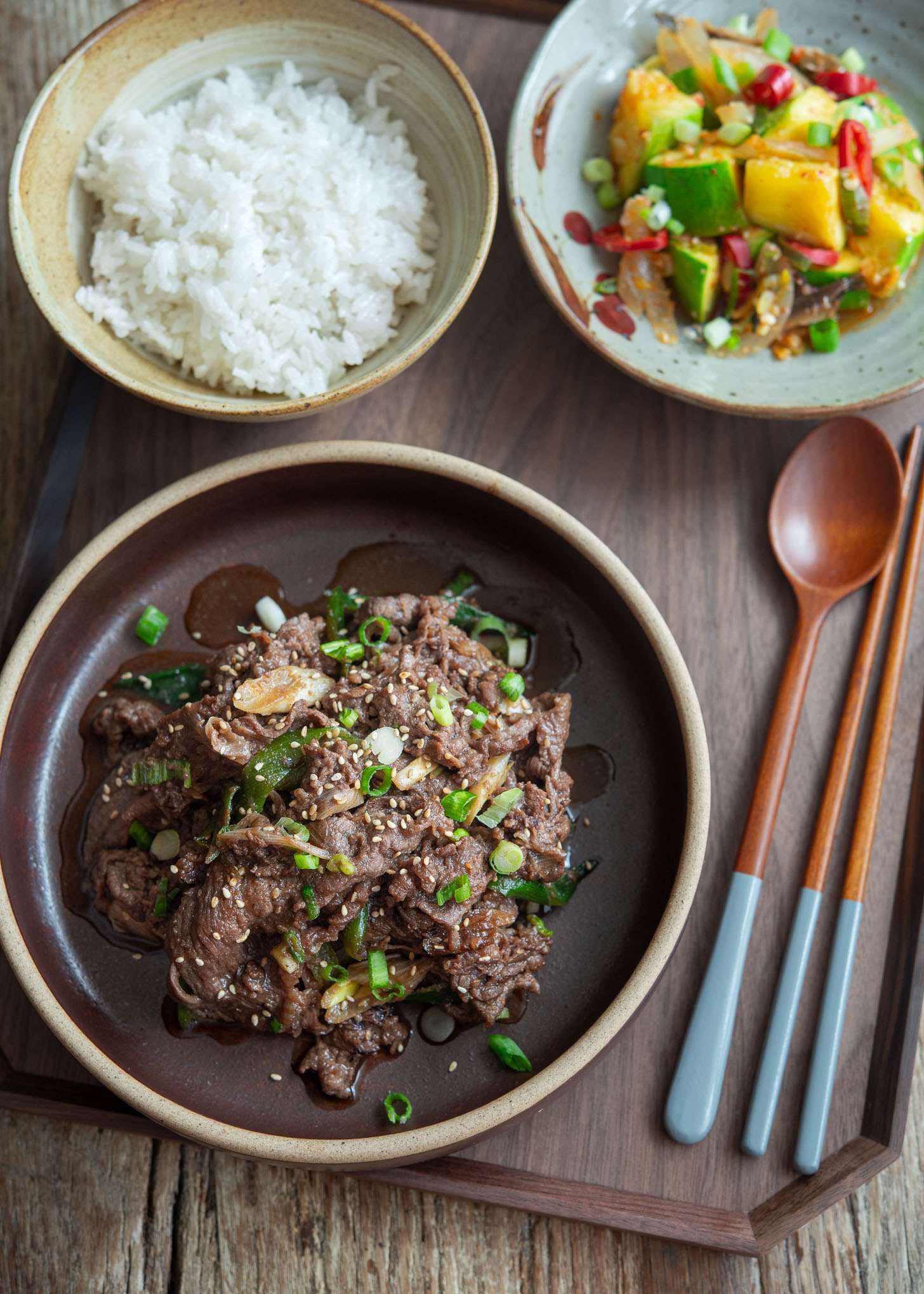
What is Bulgogi?
Bulgogi, Korea’s treasured “fire meat,” is the crown jewel of Korean BBQ recipes. Originating from the regal tables of the Joseon dynasty, this once-royal delight now sizzles on grills across modern Korean streets.
The marinade, a exquisite blend of soy sauce, sugar, garlic, green onions, sesame oil, and spices, infuses the beef with a sweet and savory depth that’s irresistibly flavorful.
Today, while variants like Chicken Bulgogi and Pork Bulgogi are popular, it’s Beef Bulgogi that remains the undisputed classic—a must-savor experience that encapsulates the essence of Korean cuisine.
Bulgogi Variations
Bulgogi isn’t a one-size-fits-all Korean dish. Its preparation and flavor profile can vary from region to region in Korea. This leads to an enjoyable exploration of Korea’s traditional cooking methods.
1. Traditional Korean BBQ Style:
Thinly sliced beef is marinated in a flavorful sauce and typically requires a few hours for the beef to tenderize and absorb the marinade. Some add mushrooms and vegetables, but keeping the focus on the beef with a hint of green onion creates a balanced taste.
2. Seoul-Inspired Variation:
A twist on the classic, this version incorporates sea kelp broth in the marinade. The beef is cooked on a special dome-shaped pan, channeling the meat juices and broth downwards, creating a rich, savory liquid perfect for drizzling over rice. Accompaniments often include Korean noodles , mushrooms, and vegetables.
Discover the full recipe for this Seoul-Style Bulgogi in my cookbook, ‘Korean Cooking Favorites‘.
3. Crispy Version from Jeolla Province:
This southern variant emphasizes a crispy exterior on the beef, achieved through a distinct cooking technique used in Jeolla Province. Unlike other versions, this Crispy Korean Beef doesn’t yield a juicy broth, but offers a satisfying crunch.
For a quick meal, consider my korean ground beef recipe, a popular twist that’s perfect for a speedy Korean ground beef bowl.
Choosing and Slicing the Beef
The choice of beef is a crucial factor in the taste and texture of your Korean BBQ dish. Typically, this traditional Korean dish utilizes thin slices of tender beef. Rib-eye or sirloin are often the preferred cuts for Bulgogi due to their perfect balance of lean meat and fat.
The rib-eye provides a wonderful blend of flavor and tenderness, while the sirloin offers a leaner option without compromising the juicy texture that makes Bulgogi so popular.
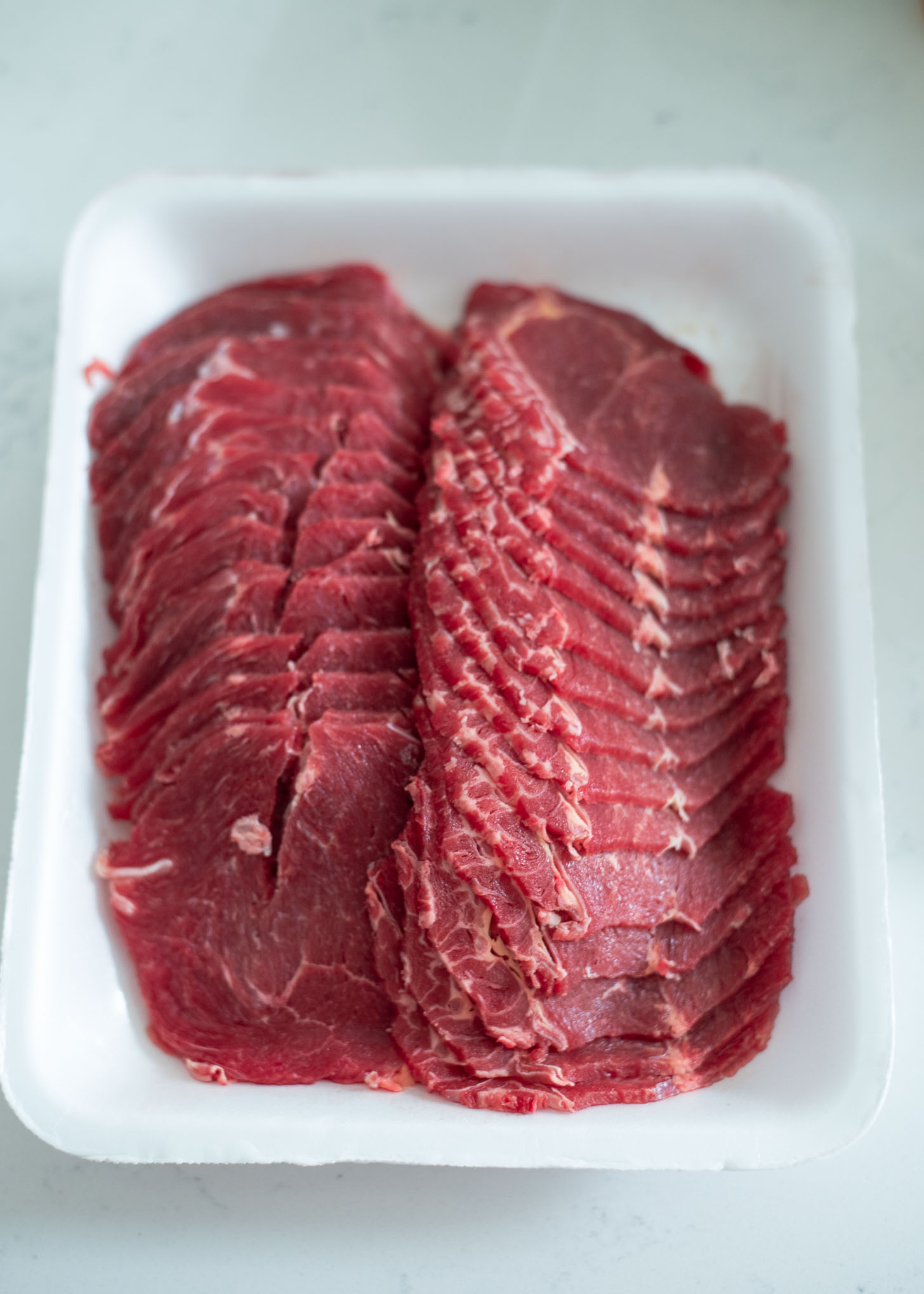
Korean-cut frozen beef slices
You’ll want to slice the beef thinly against the grain for optimal marinade absorption, yielding a flavorful and tender result. This technique also promotes quick, even cooking.
However, if you’d rather skip the slicing, Korean stores often sell pre-sliced, frozen Bulgogi meat. Simply defrost and marinate for an authentic, hassle-free Korean BBQ experience.
Homemade Bulgogi Marinade
The secret to the perfect Korean Bulgogi lies in its marinade. Making your own sauce at home is simple, and it’s a game-changer compared to store-bought options. This homemade Bulgogi marinade doesn’t require complex steps, but it does ask for a little patience.
Aim to let your beef soak in this flavorful mix for at least 4 hours, but for the best results, letting it marinate overnight is the way to go. It’s a small step that promises big, delicious rewards.
You can also make the bulgogi marinade in advance and freeze it in an airtight container for up to 3 months. Just be sure to thaw it completely in the refrigerator before cooking.
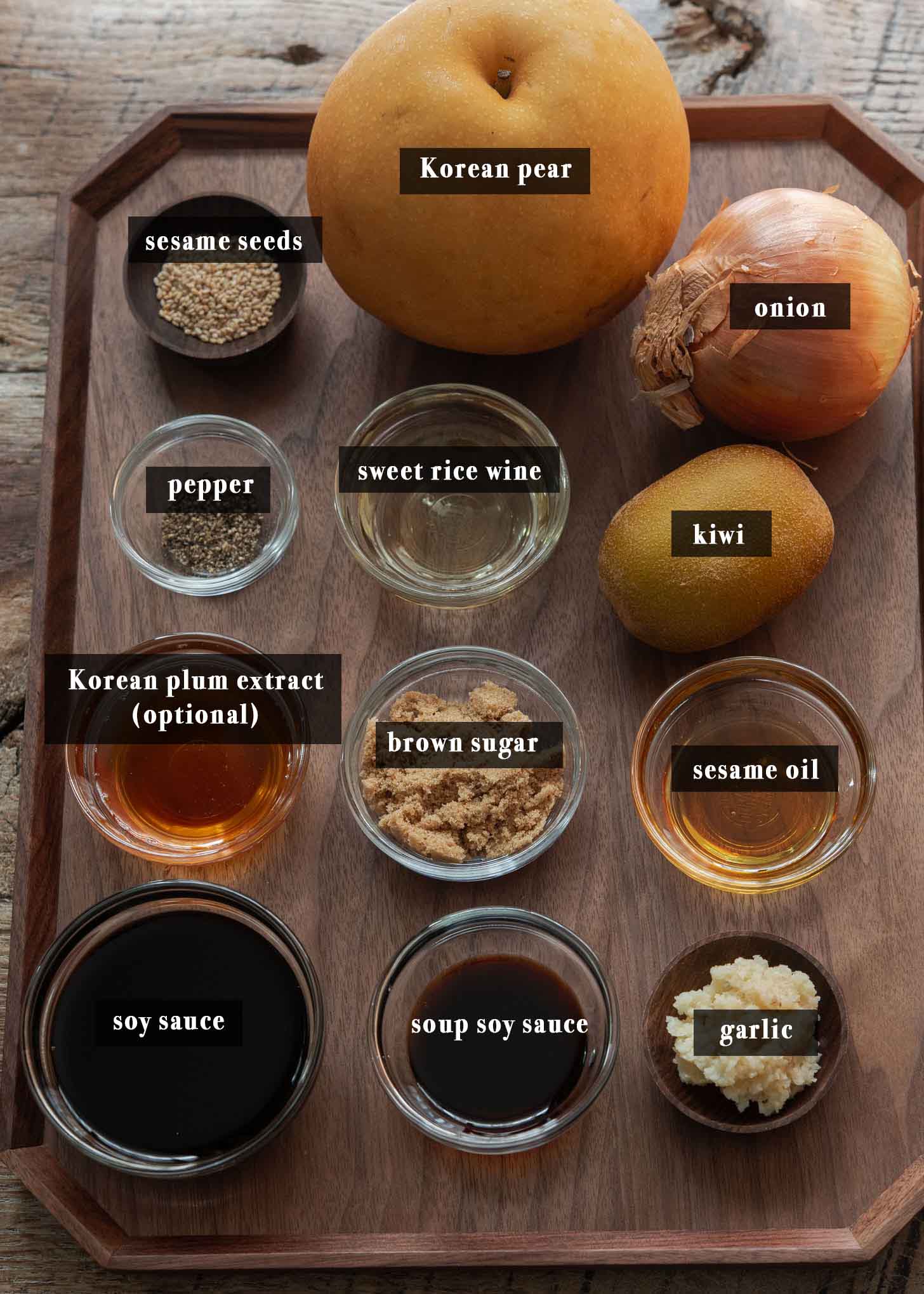
Here’s what you’ll need for the marinade:
- Asian Pear (preferably Korean pear): A secret to both flavor and tender meat.
- Kiwi: A fast-acting tenderizer; use sparingly, especially if marinating longer than 4 hours. Alternatively, use equal parts pineapple for a similar effect.
- Onion and Garlic: For a layer of savory depth.
- Soy Sauce: The foundational seasoning that brings a salty richness.
- To make this recipe gluten-free, substitute the soy sauce with gluten-free alternatives such as tamari or coconut aminos.
- Korean soup soy sauce: It adds a deep umami character to the beef. While optional, they come highly recommended for an authentic touch.
- Rice Wine: If you have it, use sweet rice wine (mirim) for a subtle, mellow sweetness.
- Brown Sugar: For that hint of caramel-like sweetness.
- Pepper: Don’t be shy; a generous amount elevates the flavors.
- Sesame Oil: The finishing touch that adds a nutty, fragrant aroma to the dish.
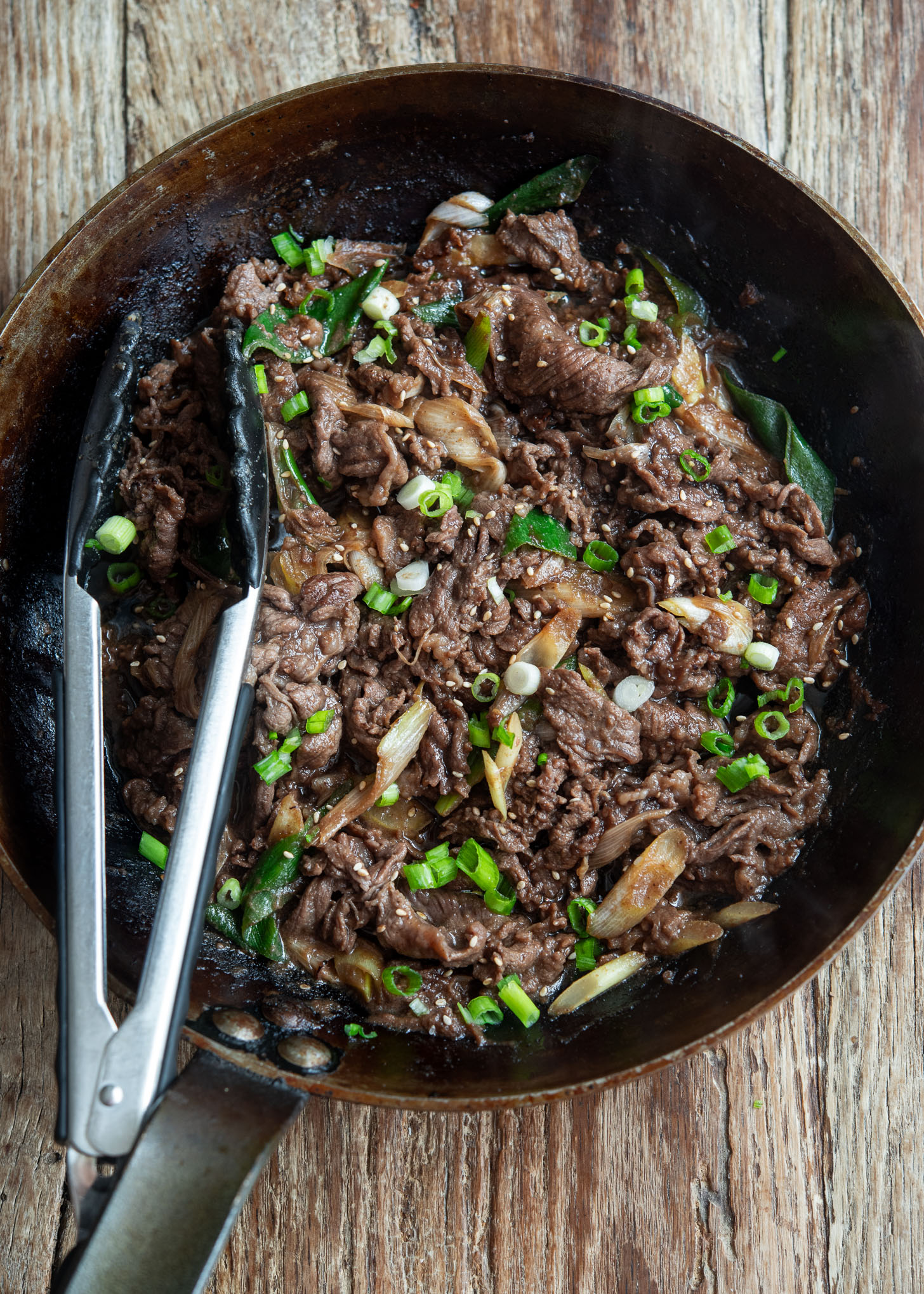
Cooking Techniques
When it comes to cooking Bulgogi, the method you choose plays a different role in the flavor and texture of the final dish.
Grilling
Grilling Bulgogi over an open flame imparts a smoky, BBQ-like essence that’s hard to replicate with other methods. This technique allows the meat to develop a wonderful charred exterior while retaining a juicy and tender inside.
Pan Frying
Pan frying is a convenient and quick way to cook Bulgogi, especially when a grill isn’t available. It still yields a delicious and flavorful dish, with the added benefit of easier clean-up and control.
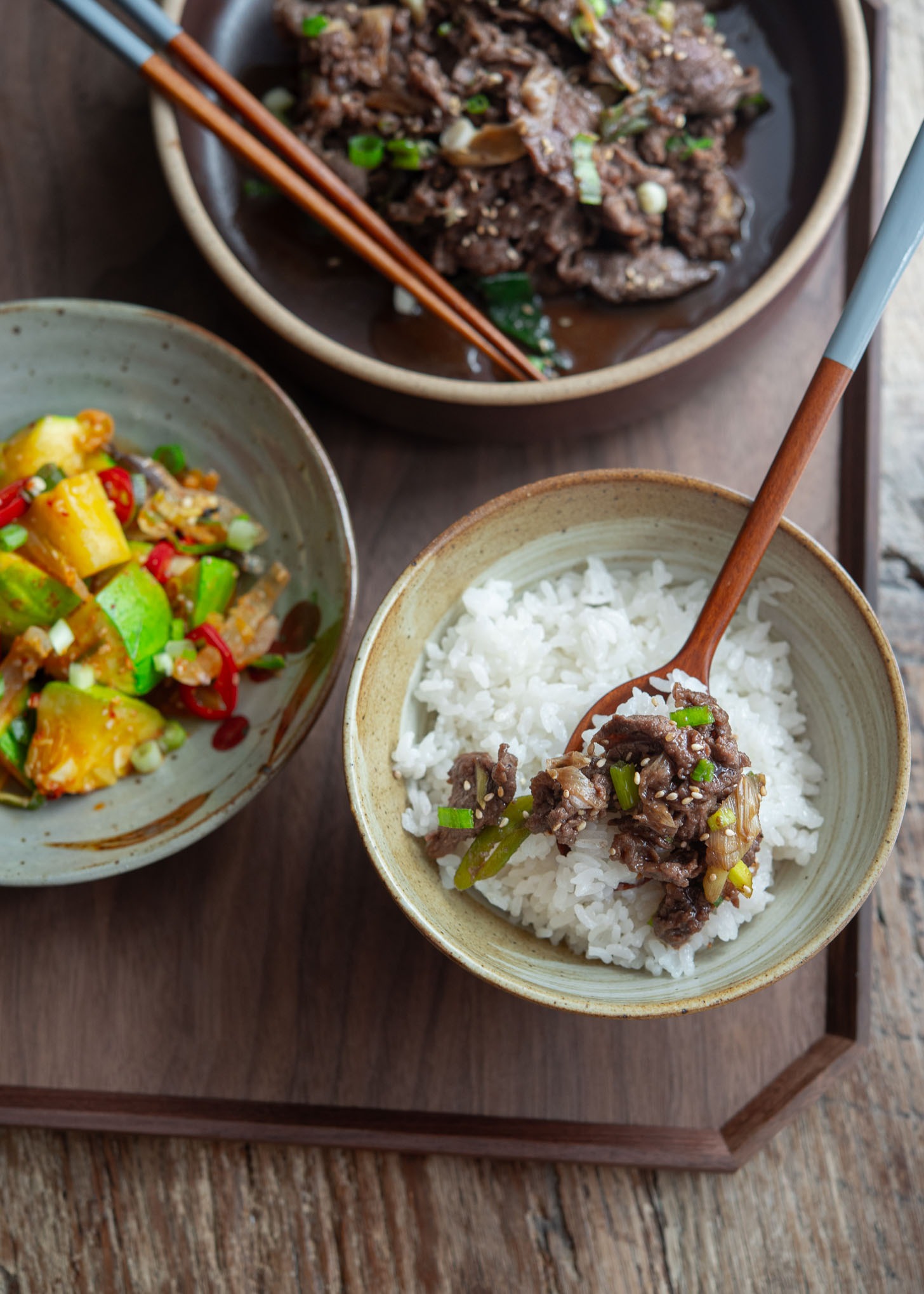
Serving Suggestions
For a simple one-bowl meal, layer Bulgogi over white rice and serve with kimchi or another vegetable side dish.
Traditionally, Bulgogi is part of a complete meal, often paired with rice, fresh vegetables, and a variety of condiments. For a hands-on dining experience, wrap bulgogi, rice, green onion salad and a smear of ssamjang in lettuce leaves.
Accompanying it with a bowl of Korea soybean paste stew is a classic restaurant move that you can easily replicate at home.
But remember, the Bulgogi—tender, juicy, and richly marinated—is the true star. Enjoy your meal with these suggested Korean side dishes:
- Cucumber Kimchi (Oi-sobagi)
- Bean Sprout Side Dish (Kongnamul Muchim)
- Spicy Cucumber Salad (Oi Muchim)
- Spinach Side Dish (Sigeumchi Namul)
- Korean Zucchini Banchan
How to Make Bulgogi: Step-by-Step Guide
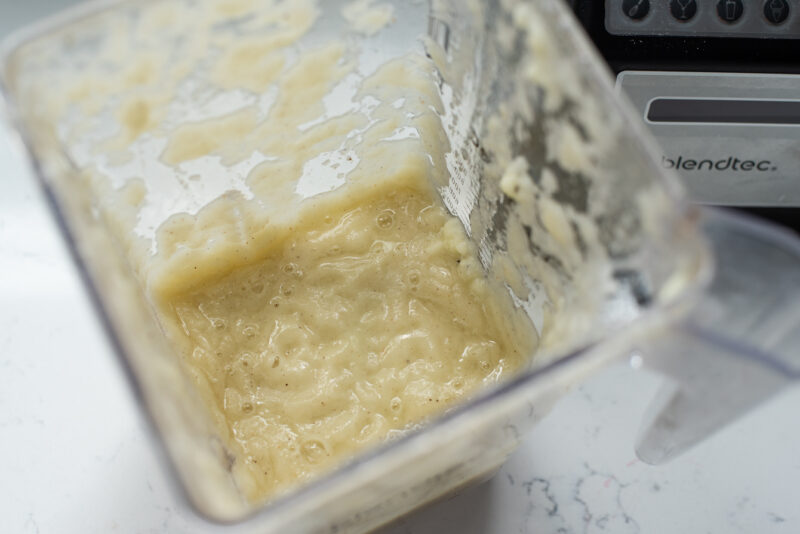
Step 1. Blend onion and fruits
- Put diced pear, kiwi, onion and garlic in a blender and process until very smooth.
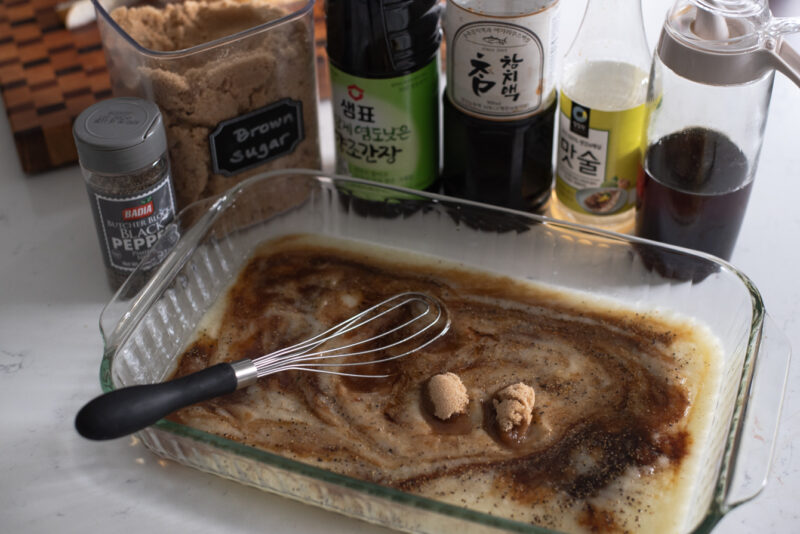
Step 2. Prepare the marinade
- Pour the onion/fruit puree into a large shallow pan – a 9×13-inch Pyrex baking pan (with a lid) is perfect for this.
- Add soy sauce, tuna sauce (or soup soy sauce), rice wine, Korean plum extract (if using), brown sugar, pepper and sesame oil; mix well.
- You can make this marinade sauce ahead of time and keep it in the refrigerator for up to 1 week.
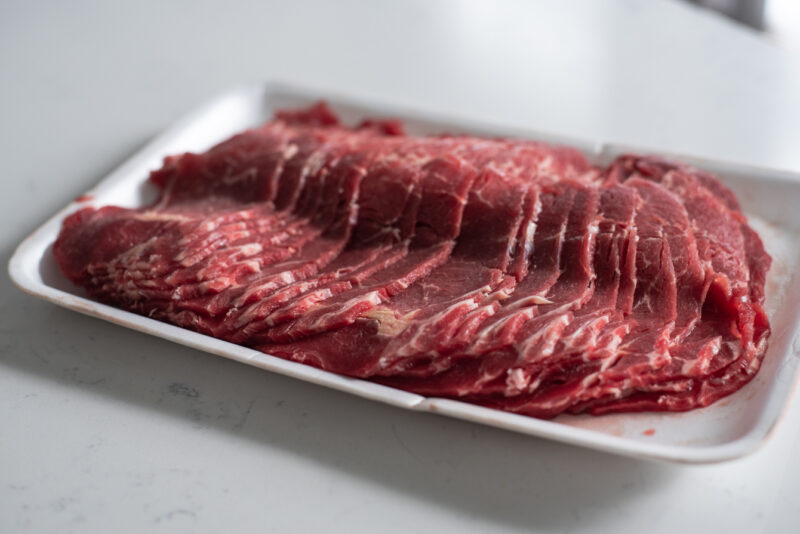

Step 3. Prepare the beef (optional but recommended).
- Dab sliced beef with a paper towel to remove the extra red myoglobin from the surface. It helps get rid of unpleasant gamy smell if the beef was frozen too long.
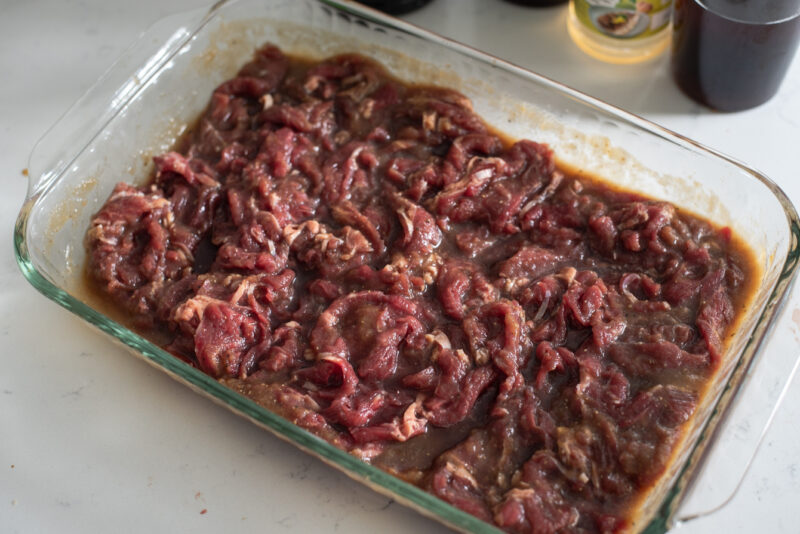
Step 4. Marinate the beef.
- Separate the thin beef slices and add them to the marinade sauce. Toss gently by hand to combine everything with a slight massaging motion. Cover and marinate for at least 1 hour or up to overnight.
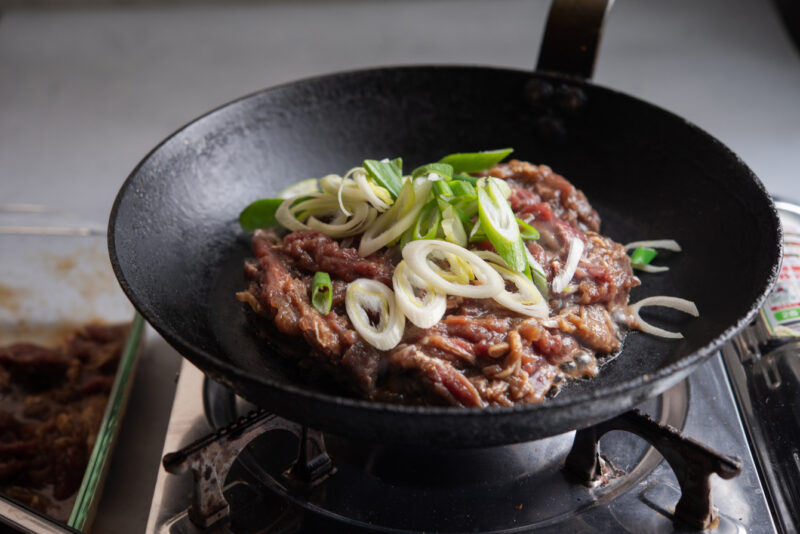
Step 5. Cook marinated beef in a very hot skillet
- Heat a heavy skillet (cast iron is ideal) very hot over medium-high heat. Do Not Add any vegetable oil! Add the beef.
- You can add sliced Asian leek on top as I did, or onion or green onion. You can also add thinly sliced carrot, or pepper if you want it to be more wholesome, but then, it won’t be a classic bulgogi.

Step 6. Cook beef in its own marinade sauce.
- The beef should sizzle as soon as it touches the hot skillet. Let the meat cook in its own juice. Toss the meat around to cook evenly and thoroughly, about 2-3 minutes. It should cook very quickly.
- Sprinkle with sesame seeds and green onion to garnish.

Storing and Reheating Tips
To store Bulgogi, let it cool to room temperature and place it in an airtight container. It stays fresh in the fridge for up to 3-4 days, or you can freeze it for up to 3 months.
You can also freeze marinated beef in an airtight container for up to 3 months. Just be sure to thaw it completely in the refrigerator before cooking.
For reheating, warm Bulgogi gently in a pan over medium heat. If it’s dry, add a splash of water. For frozen Bulgogi, thaw it in the fridge overnight before reheating. If you’re short on time, use the microwave: place the Bulgogi in a microwave-safe dish, cover it loosely, and heat on medium power until warm.
Remember, it’s best to reheat Bulgogi only once to keep it juicy and flavorful.
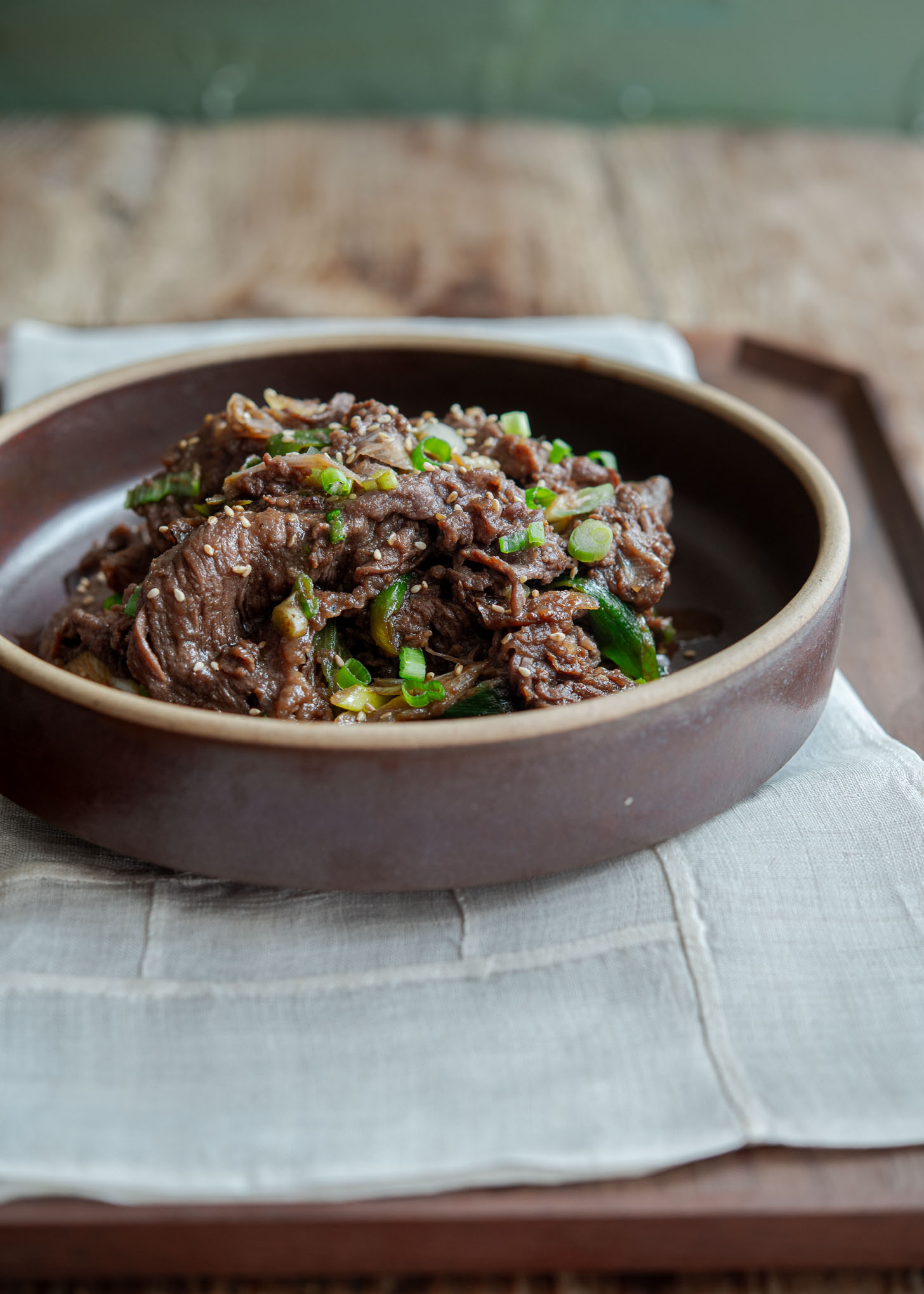
Other Iconic Korean Dishes to Explore
Don’t miss out on these famous Korean recipes. They are easy to make at home and tastes just like what you eat at Korean restaurants if not better.
- Samgyupsal (Korean BBQ Pork Belly)
- 20-Minute Authentic Tteokbokki (Spicy Korean Rice Cake)
- Kimbap (Korean Seaweed Rice Roll)
- Crispy Korean Fried Chicken (Chimaek)
- Japchae: Korean Stir-Fried Glass Noodles
Loved this Korean beef recipe? Share your cooking experience in the comments. For more Korean recipes, subscribe to our newsletter!
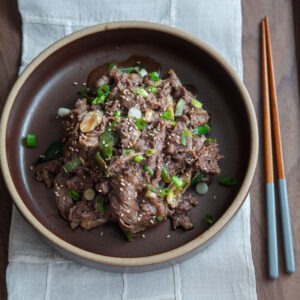
Classic Bulgogi Recipe (Korean BBQ Beef)
Recipe Video
Ingredients
- 2 lb (900 g) beef sirloin or rib eye , thinly sliced, about 1/8-inch thick
- 1 Asian leek or 3 green onion, sliced
Bulgogi marinade
- 1/2 large Asian pear , peeled and diced. See note for substitution
- 1/4-1/2 kiwi, peeled and diced. See note below
- 1/2 large onion , diced
- 4 cloves garlic
- 5 tbsp soy sauce
- 1 tbsp Korean soup soy sauce (gukganjang)
- 2-3 tbsp light brown sugar
- 2 tbsp sweet rice wine (mirim)
- 2 tbsp Korean plum extract (maeshil cheong), optional
- 1/2 tsp black pepper
- 1 tbsp sesame oil
- 2 tsp toasted sesame seeds
Instructions
To marinate beef
- To make bulgogi marinade, put pear, kiwi, onion, and garlic in a blender and process until very smooth.
- Pour the onion/fruit puree into a large shallow pan – a 9×13-inch pyrex baking pan (with lid) is perfect for this. Add soy sauce, Koran soup soy sauce, brown sugar, rice wine, Korean plum extract (if using), pepper and sesame oil; mix well. You can make this marinade sauce ahead of time and keep it in the refrigerator for up to 1 week.
- Dab the beef with a paper towel to wipe out extra liquid on the package if there's any. Separate the beef slices and add them to the marinade sauce. Toss gently by hand to combine everything with a slight massaging motion. Cover and marinate for at least 1 hour or up to overnight.
To cook bulgogi
- Heat a skillet very hot over medium-high heat. Do not add any oil! Add the beef. You can add sliced Asian leek or green onion on top. The beef should sizzle as soon as it touches the hot skillet. Let the meat cook in its own juice. Toss the meat around to cook evenly and thoroughly, about 2-3 minutes. It should cook very quickly.
- Sprinkle with sesame seeds and green onion to garnish. Serve warm with rice and a vegetable side dish.


Hi there! Thanks so much for sharing your recipe! I enjoyed the process and followed your direction to a T. Unfortunately it was a bit too sweet (which I will lessen the sugar next time) but also I was disappointed that it was not tender enough. I did use pear and kiwi and marinate for at least 24 hours. My daughter was disappointed that it was not as tender as what she had at my friend’s house. What could I have done wrong? Years ago, I made a bulgogi marinade but it was over tenderized so the texture was not really good. Would love your feedback…
Hi Kate
I’m sorry to hear that your bulgogi isn’t as tender as you’d like. Without knowing the specific type of beef you used, pinpointing the exact issue can be challenging. However, using a tender cut of beef, such as sirloin or ribeye, that has been sliced against the grain can significantly enhance the tenderness of your bulgogi. The thickness of the beef slices also plays a crucial role. In traditional Korean cuisine, beef is typically sliced very thinly, usually to about 1/8-inch or even less. It’s so thin that it tends to tear as you mix it with the marinade.
Another tip I would suggest is to bring the beef to room temperature before adding it to a hot skillet. And yes, marinating the meat for too long with these fruits can cause the exterior to become mushy or negatively affect its texture due to protein breakdown. I hope this helps. Thanks!
What other kind of vegetables can I put in it
You can add carrot, zucchini, green pepper and extra green onion to this recipe. But mindful that adding extra veggies will thin out the bulgogi taste from the meat. Thanks!
What other veggies can I put in it
This is a staple in our house! My husband requests it weekly!!
Yay! So happy to hear that!
Is the old recipe still available? This was my go-to bulgogi recipe and I noticed it changed a lot! Added kiwi, skipped the myeolchi broth step, etc. While I’m sure this version is delicious and a little less labor intensive, it’s the version my Korean husband approves of!
Hi Andrea
The major difference between the two is that the old version has anchovy broth added. You can add 1/2 cup of anchovy sea kelp broth to the marinade. You can skip the kiwi, or used crushed pineapple (2 tbsp) instead. If you skip the kiwi, make sure to marinate overnight. The old version also uses mushroom and onion as an additional topping. You can either cook together with bulgogi, or saute them separately and top over bulgogi. Hope this helps.
I had my first taste of beef bulgogi this past summer, and it has become my favorite way to eat beef sirloin! Now I’m out camping, and introducing new friends to authentic Korean dishes!
I had a craving for bulgogi and this hot the spot!! The flavors were incredible, you’d never know there was pear and kiwi, it all worked so well!
Hi Annie
I’m glad that this bulgogi satisfied your craving. Yes, the pear and the kiwi does the wonder to make the beef more flavorful. Thanks for the comment!
Fabulous recipe! Thank you for this. It tasted just like I remember from living in South Korea as a kid.
I absolutely love Korean culture. Especially the food. It’s so yummy. 🙂
I haven’t tried this dish yet, but I’ve made japchae 3 or 4 times for my family. I am getting pretty good at it. I am so excited to learn more about the cuisine.
Are there any specific recipes that you suggest for a beginner cook? (I am still a teenager, ehehe)
Thank you so much!!
Hi Emily
You impressed me. I am so happy to know that you are getting good at Korean cooking. Here are a few recipes that I suggest you to try.
Spicy Pork bulgogi: https://www.beyondkimchee.com/spicy-korean-pork/
Chicken Bulgogi: https://www.beyondkimchee.com/chicken-bulgogi-korean-chicken-bbq/
Tteokbokki (spicy rice cakes): https://www.beyondkimchee.com/spicy-korean-rice-cakes/
Korean Army Stew: https://www.beyondkimchee.com/korean-army-stew-budae-jjigae/
Ramen Stir-Fry with Vegetables: https://www.beyondkimchee.com/10-minute-ramen-stir-fry-vegetables/
Korean Honey Garlic Chicken Wings: https://www.beyondkimchee.com/korean-honey-garlic-chicken-wings/
Kimchi Fried Rice: https://www.beyondkimchee.com/kimchi-bacon-fried-rice/
Pan-Fried Tofu: https://www.beyondkimchee.com/pan-fried-tofu/
Easy Kimchi Recipe: https://www.beyondkimchee.com/easy-cabbage-kimchi/
Keep up the good work! Don’t hesitate asking any question if you have.
Oh this looks terrific! I love Korean BBQ and Bulgogi, so thank you for sharing the recipe adopted to a pan!
Fantastic, and surprisingly flexible. I didn’t have a pear or kiwi so substituted a grated apple. I think it did the trick. I also used london broil sliced thin. If was still delicious.
My hubby loves bulgogi — such a delicious and flavourful meat! I wish I can have some right now!
Terrific post! I’m lucky in that my local supermarket sells thinly sliced beef that’s appropriate for this dish — so less work for me to do. 🙂 Haven’t made this dish in what seems like forever, and now you have me craving it. 🙂 Really good stuff — thanks.
Thanks so much for the recipe. I only have regular soy sauce so for the marinade I am sure I need less. Any suggestion how many tablespoon needed and do I need to add water maybe to make it 7 tbsp?
The love story you want is Sleepless in Seattle. The recipe is awesome. Can you now please give me your ssamjang recipe?
This looks absolutely deelish and I’m going to make it soon! I love the taste of ginger, would adding a little hurt anything?
Adding a just little bit of ginger will enhance bulgogi nicely. Go for it.
Gawd that sounds delicious… bulgogi at a Korean BBQ place is still the most delicious meat memory I’ve ever put in my mouth… yours looks divine. When I can eat again I will be trying this recipe for sure.
This was divine…..I think your special sauce and not adding the veggies right away helped make this one of the most beautiful bulgogi ever!
thank you again
Michel
Hi,
I made your bulgogi recipe for a party I hosted this weekend. It was soooo delicious, and a big hit with my guests!
My husband can’t wait for me to make it again. Thank you!
Jenny
Your blog, all of it, is food porn to me. <3
Thank you!
Yes.
Just went to a Korean shop today looking for dried sea kelp but found a dried sea tangle….are these two the same?
this looks yummy..I'll try to cook this next time 🙂
This is the best Bulgogi I've ever had. Thanks for sharing.
Please let me know how he thinks. Hope he likes it.
It looks absolutely delicious! I will make it tonight and let's see what my Korean husband has to say about it 🙂
Thanks sweetie. They were mighty tasty.
I would never tire of bulgogi and yours look yummylicious!!!